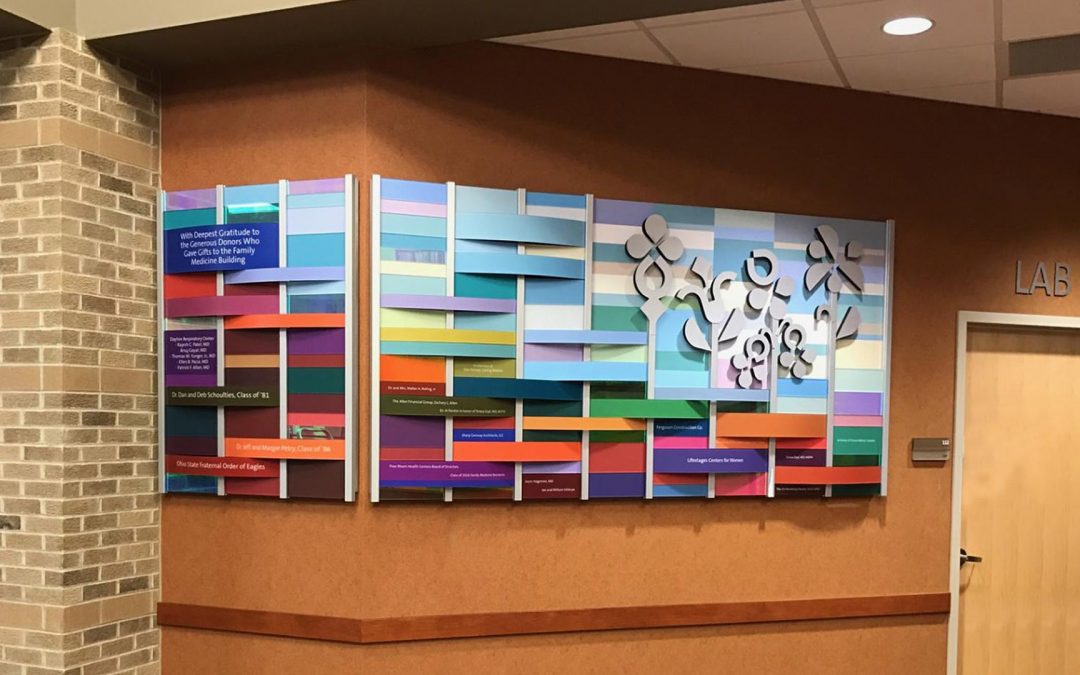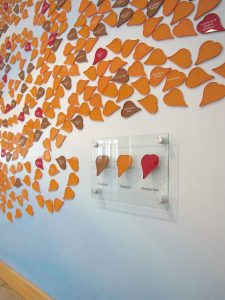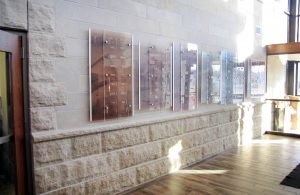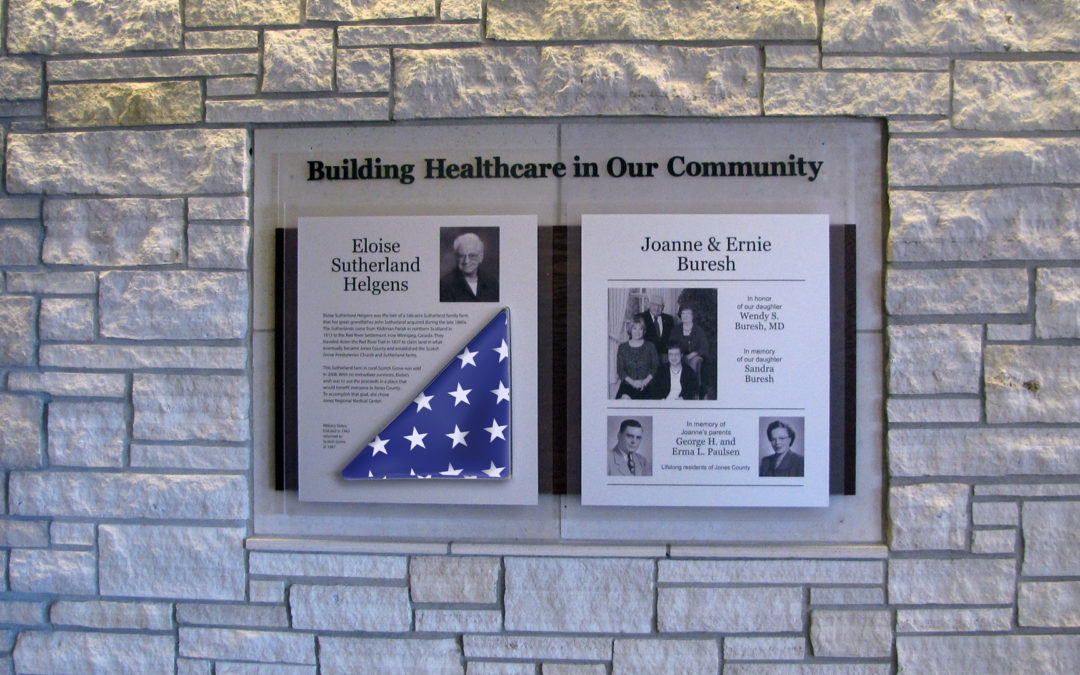
 Celebrate your donors with a donor recognition wall that represents your organization and the money your raised. Engraved tiles are a thing of the past and look more like tombstones than a giving campaign. Donor walls made up of engraved blocks and printed lists are the most common and easiest to build, but do they really represent all the hard work and effort that went into your giving campaigns? Donor walls should not be an after thought, but a part of your campaign budget. Donor walls should catch attention and engage people to give. Donor walls are a great opportunity to express your vision and mission through visual artwork and promote your campaigns. Donor walls with lists can be special just by adding personal photos. Your donors want to feel special and you have an obligation to make that happen.
Celebrate your donors with a donor recognition wall that represents your organization and the money your raised. Engraved tiles are a thing of the past and look more like tombstones than a giving campaign. Donor walls made up of engraved blocks and printed lists are the most common and easiest to build, but do they really represent all the hard work and effort that went into your giving campaigns? Donor walls should not be an after thought, but a part of your campaign budget. Donor walls should catch attention and engage people to give. Donor walls are a great opportunity to express your vision and mission through visual artwork and promote your campaigns. Donor walls with lists can be special just by adding personal photos. Your donors want to feel special and you have an obligation to make that happen.

How to begin:
- Look at a companies portfolio
- Interview former clients
- Interview the company
Find a company you are comfortable in working with and tell them what you are envisioning. Any company that is willing to give away their designs to get the build, is going to give you a stock design that is off the shelf. If you want something original, you will pay for design and in the end get something you can be proud of and is original to you. You probably think, it is going to cost a lot more, but when you compare prices, you will be surprised. Donor walls don’t have to be boring once you see them as artwork. Presentations custom designs and builds every display with an artistic eye and quality engineering. We consider the space, architecture and the purpose of the client and the campaign. Sometimes we recommend painting the wall or design custom wallpaper to be background for the donor wall. Presentations donor walls are not cookie-cutter versions of the same thing over and over, but special for you.

Our hospital has undergone major renovations, resulting in re-location of a number of services. In some areas there are plaques dating back many years, recognizing gifts of donors to a specific service (eg. – pediatrics or endoscopy.) We call these “dedication plaques”. What is a good policy for removing donor plaques.
A Foundation’s foremost concern is the appropriate recognition of our donors’ generosity. From time to time, modifications, renovations, or changes to an area’s use may require adjustments in a naming opportunity.
1. If a space undergoes minor renovations and the purpose of the space remains substantially the same, then any original naming designation will remain in place.
2. When a space undergoes a significant renovation or change in purpose, or the designated program ceases to exist or experiences a dramatic change in its needs, the Foundation will discuss options with the naming and lead donors (or their survivors) to that structure or program. Options for the naming opportunity may include, but are not limited to, continuing the naming opportunity with modification, moving the naming opportunity to a new or comparable, existing space, or altering the size of the space assigned to the naming opportunity.
3. When the useful life of a facility ends or the function supported by a gift ends or moves out, the Foundation will discuss options with the naming and lead donors involved or their survivors. Among the options will be those outlined above and the opportunity for donors to fund new construction of a new area or major renovation to a fully reconfigured area in order to sustain the original naming opportunity. Whatever the donors’ decision, the Foundation may move recognition of original gifts to a permanent plaque or similar structure elsewhere in the hospital to continue honoring past gifts. A Living History wall or Legacy Display in the Hospital is currently under consideration as a way to perpetuate the recognition of donors whose named areas have been removed.
4. The naming of a building by a donor will extend for the life of the building. In the event the named building is demolished, the donor is entitled to recognition for a minimum of thirty (30) years. If the named building is razed in fewer than 30 years, the Foundation will arrange with the donor and/or the donor’s family to select a comparable area. If the named building is demolished after a period of 30 or more years, the Foundation will not be obligated to continue the naming recognition.

 Celebrate your donors with a donor recognition wall that represents your organization and the money your raised. Engraved tiles are a thing of the past and look more like tombstones than a giving campaign. Donor walls made up of engraved blocks and printed lists are the most common and easiest to build, but do they really represent all the hard work and effort that went into your giving campaigns? Donor walls should not be an after thought, but a part of your campaign budget. Donor walls should catch attention and engage people to give. Donor walls are a great opportunity to express your vision and mission through visual artwork and promote your campaigns. Donor walls with lists can be special just by adding personal photos. Your donors want to feel special and you have an obligation to make that happen.
Celebrate your donors with a donor recognition wall that represents your organization and the money your raised. Engraved tiles are a thing of the past and look more like tombstones than a giving campaign. Donor walls made up of engraved blocks and printed lists are the most common and easiest to build, but do they really represent all the hard work and effort that went into your giving campaigns? Donor walls should not be an after thought, but a part of your campaign budget. Donor walls should catch attention and engage people to give. Donor walls are a great opportunity to express your vision and mission through visual artwork and promote your campaigns. Donor walls with lists can be special just by adding personal photos. Your donors want to feel special and you have an obligation to make that happen.

